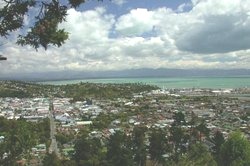Nelson New Zealand Information
Home > New Zealand Information > Nelson Information
Nelson
From Wikipedia, the free encyclopaedia.
| Nelson | ||
|---|---|---|
|
Nelson New Zealand. | ||
| Urban Area | Population | 57,700 |
| Extent | from Glenduan to the Wairoa River |
|
| Unitary authority |
Name | Nelson City |
| Population | 44,400 | |
| Extent | from Rai Saddle to
Stoke |
|
| See also | Tasman District | |
The city of Nelson stands on the eastern side of Tasman Bay at the northern end of the South Island of New Zealand. The hinterland formed the traditional province of Nelson, now incorporated into the Tasman District. Nelson received its name in honour of the 1st Viscount Nelson. Nelson is one of the regions of New Zealand and is administered as a unitary authority.
Many people believe Nelson has the best climate in New Zealand, in that it regularly tops the national statistics for sunshine hours, with an annual average total of over 2400 hours.
Nelson has good beaches and a sheltered harbour. It lies close to mountains and to Lakes Rotoiti and Rotoroa in the Nelson Lakes National Park, and functions as the gateway to the Abel Tasman National Park and to the Kahurangi National Park.
The geographical "Centre of New Zealand" allegedly lies in Nelson; on a hilltop suspiciously convenient to the centre of the city. This supposed "centre" in fact simply marks the point deemed the "centre" for the purposes of early geographical surveys. The *true* geographical centre lies in a patch of unremarkable dense scrub in a forest on the Spooners Range.
Nelson serves as a centre for arts and crafts, and each year hosts popular events such as the Nelson Arts Festival and the World of WearableArt Awards. Nelson also has a good music scene, with bands such as Mother Guru, The Housewives, Monkey Puzzler and Everthirst performing regular gigs around the region.
Nelson Province is the birthplace of Ernest Rutherford, and he attended Nelson College.
The first rugby match in New Zealand took place at the Botanic Reserve in Nelson on May 14, 1870, between the Nelson Football Club and Nelson College.
The Nelson urban area, which includes the adjacent town of Richmond, has a population of approximately 50,000 - and has recently increased in population more rapidly than any other region in New Zealand bar one.
Early History of Nelson
The New Zealand Company in London planned the settlement of Nelson. They intended to buy cheaply from the Maori some 200 00 acres (800 km²) which they planned to divide into one thousand lots and sell (at a considerable profit) to intending settlers. The Company earmarked future profits to finance the free passage of artisans and labourers and their families, and for the construction of public works. However by September 1841 only about one third of the lots had sold. Despite this the Colony pushed ahead.
Three ships sailed from London under the command of Captain Arthur Wakefield. Arriving in New Zealand, they discovered that the new Governor of the colony, William Hobson would not give them a free hand to purchase vast areas of land from the Maori or indeed to decide where to site the colony. However, after some delay, Hobson allowed the Company to investigate the Tasman Bay area at the north end of the South Island. The Company selected the site now occupied by Nelson City because it had the best harbour in the area. But it had a major drawback: it lacked suitable arable land; Nelson City stands right on the edge of a mountain range while the nearby Waimea Plains amount to only about 60 000 acres, less than one third of the area required by the Company plans.
The Company purchased from the Maori for eight hundred pounds a vague and undetermined area, but including Nelson, Waimea, Motueka, Riwaka and Whakapuaka. This allowed the settlement to begin, but the lack of definition would prove the source of much future conflict. The three colony ships sailed into Nelson Haven during the first week of November 1841. When the first immigrant ships arrived three months later they found the town already laid out with streets, some wooden houses, tents and rough sheds. Within eighteen months the Company had sent out eighteen ships with 1052 men, 872 women and 1384 children. However less than ninety of the settlers had the capital to start as landowners.
Notably, the early settlement of nelson Province included a proportion of German immigrants, who arrived on the ship Sankt Pauli and formed the nucleus of the villages of Sarau (Upper Moutere) and Neudorf.
After a brief initial period of prosperity the inherent problems, the lack of land and the lack of capital caught up with the settlement and it entered a prolonged period of relative depression. Organised immigration ceased until the 1850s and the laborers had to accept a cut in their wages by a third. By the end of 1843 artisans and laborers began leaving Nelson and by 1846 some twenty five percent of the immigrants had moved away.
The pressure to find more arable land became intense. To the south-east of Nelson lay the wide and fertile plains of the Wairau Valley. The New Zealand Company tried to claim that they had purchased the land. The Maori owners stated quite adamantly that the Wairau Valley had not formed part of the original land sale and made it clear they would resist any attempts by the settlers to occupy the area. The Nelson settlers led by Arthur Wakefield and Henry Thompson attempted to do just that. This resulted in the Wairau Massacre (euphemistically: the Wairau affray; even more euphemistically: the Wairau Incident) wherein twenty-two settlers died. The subsequent Government enquiry exonerated the Maori and found that the Nelson settlers had no legitimate claim to any land outside Tasman Bay.



